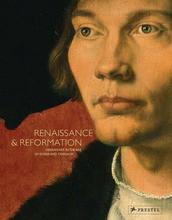More about Lucas Cranach the Elder
- All
- Info
- Shop
Works by Lucas Cranach the Elder

Sr. Contributor
It's possible you could own a painting by Lucas Cranach the Elder and never even know.
His father, and first art teacher, was Hans Maler. As far as academia is concerned, there aren't any known paintings by Hans currently in museums or private collections. But, between his last name meaning 'painter' and the fact that he had the dopest house in Kronach's hip Markplatz neighborhood, it's safe to say Lucas's old man was a good teacher.
Lucas' training is self-evident in his appointment as court painter to Frederik the Wise, Elector of Saxony, earning two-and-a-half times his predecessor's salary. In addition to all the skrilla, Frederick gave Lucas a kickass coat-of-arms: A serpent with bat wings and a golden ring in its mouth. House Slytherin for life. (The image is actually thought to be a play on Cranach's name sounding like the Greek word Kronos, A.K.A "time.")
Lucas was your typical Renaissance man. In addition to painting, Cranach ran an apothecary, a highly successful printing business, and did some hardcore political meddling. He was elected to the Wittenberg town council before being thrice a burgomaster, which is a dumb word for mayor. Cranach's fame grew such that young artists flocked to Wittenberg just for him. In no time, the city became the primo arts center on the Danube.
He was chief propagandist of the Reformation. If you have an opinion about Protestant Christianity, this guy helped form it. He's responsible for those portraits of Martin Luther you find in every high school history textbook. The one where Luther looks like he's going to talk about his favorite French film whether you want him to or not. The Protestant cause didn't disrupt Lucas' profits though. He painted Luther's archenemy, Cardinal 'You Can Call Me' Albrecht von Brandenburg as St. Jerome, the standard depiction for church leaders who wanted to look real smart.
Lucas didn't always sign his paintings. But, when he did, he used LC, and sometimes his coat-of-arms. Very few works have a date. His son, Lucas Cranach the Younger, signed paintings in the same manner. Sometimes, it's impossible to tell which Lucas did the painting. Given that the epitaph on the Elder's tombstone reads Pictor celerrimus, "Swiftest of painters," there's a lot of Cranach on the streets, and there's no way to tell where it all came from.
The Norton Simon Museum currently has a Cranach problem. Specifically with Adam and Eve. These twinsie paintings belonged to a Dutch-Jew art dealer who fled Holland in a hurry during the Nazi blitzkrieg on Holland. The Nazis called dibs on the paintings after raiding the art dealer's stash. The Allies repatriated Adam and Eve to Holland after the war. The art dealer's widow never asked for the paintings back. The Dutch government waited until 1966 before selling them to an American. Long story short, the family of the Dutch owner wants take-backs, and the Norton Simon is claiming finder's-keepers. The Supreme Court refused to hear the case, and now a jury will determine ownership of the paintings in a trial starting March 29, 2016. So... stay tuned for that!

Contributor
Lucas Cranach the Elder was an artist, printmaker, businessman, politician.
His businesses included very successful apothecary -- our equivalent to your neighborhood drugstore. He also had license to sell wine, hence the need for the drugstore for hangover remedies.
Cranach’s specialty was portraits. The fast photo man of his day, he delivered 60 portraits in one day. He was so devoted to Frederick III the Wise that he followed him to prison for two years.
Close friend of Protestant Reformer Martin Luther, Cranach created violent anti-Catholic images mocking the Catholic Church. Cranach was fiercely devoted to one of his patrons, Frederick III the Wise, Elector of Saxony, who protected Luther by letting him hide at Wartburg Castle after the Diet of Worms. In fact, Cranach was so devoted to Frederick, that he followed him to prison for two years.
Hitler's best friend and wingman, Hermann Goering, was a huge Cranach fan and collected his works. According to the Deutsches Historisches Museum website dedicated to Goering's art collection, he owned 66 Cranach paintings!
Featured Content
Here is what Wikipedia says about Lucas Cranach the Elder
Lucas Cranach the Elder (German: Lucas Cranach der Ältere [ˈluːkas ˈkʁaːnax deːɐ̯ ˈʔɛltəʁə]; c. 1472 – 16 October 1553) was a German Renaissance painter and printmaker in woodcut and engraving. He was court painter to the Electors of Saxony for most of his career, and is known for his portraits, both of German princes and those of the leaders of the Protestant Reformation, whose cause he embraced with enthusiasm. He was a close friend of Martin Luther. Cranach also painted religious subjects, first in the Catholic tradition, and later trying to find new ways of conveying Lutheran religious concerns in art. He continued throughout his career to paint nude subjects drawn from mythology and religion.
Cranach had a large workshop and many of his works exist in different versions; his son Lucas Cranach the Younger and others continued to create versions of his father's works for decades after his death. He has been considered the most successful German artist of his time.
Check out the full Wikipedia article about Lucas Cranach the Elder





















